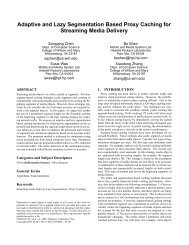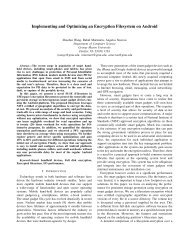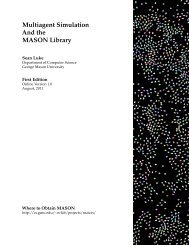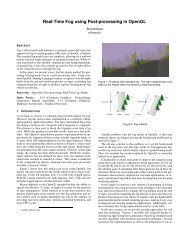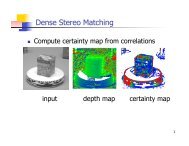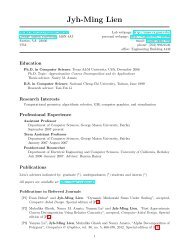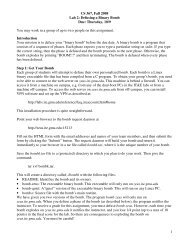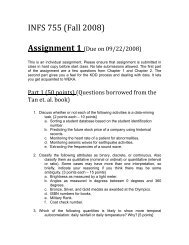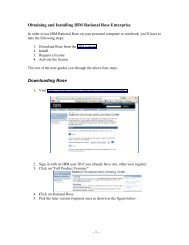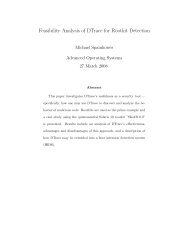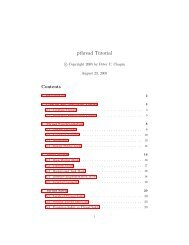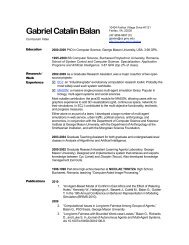CS485 - Homework 1 Due date: February 16th
CS485 - Homework 1 Due date: February 16th
CS485 - Homework 1 Due date: February 16th
Create successful ePaper yourself
Turn your PDF publications into a flip-book with our unique Google optimized e-Paper software.
<strong>CS485</strong> - <strong>Homework</strong> 1<br />
<strong>Due</strong> <strong>date</strong>: <strong>February</strong> <strong>16th</strong><br />
Be as concise as possible.<br />
1. (5) Consider rigid body transformations in the plane. Draw a right triangle defined by three<br />
points A = (2,1),B = (4,1),C = (4,6).<br />
• Consider a rotation matrix<br />
T1 =<br />
a. What is the determinant of the matrix ?<br />
• Consider transformation matrix<br />
T2 =<br />
cosθ −sinθ<br />
sinθ cosθ<br />
sinθ cosθ<br />
cosθ −sinθ<br />
a. Is the matrix orthonormal ? What is the determinant of the matrix ?<br />
c. Is T2 rigid body transformation ? What is the difference between T1 and T2, how are<br />
the results different?<br />
2. (5) Point PA = [p1, p2, p3] T expressed in a stationary frame A is rotated about axis ZA by θ<br />
degrees and then rotated around axis XA by φ degrees. Give a rotation matrix that accomplishes<br />
these two rotations. Both of the rotations are around stationary frame.<br />
3. Let R ∈ SO(3) be a rotation matrix generated by rotating about a unit vector ω by θ radians<br />
that satisfies R = exp( ˆωθ).<br />
Consider following rotation matrix:<br />
⎡<br />
0.1729 −0.1468 0.9739<br />
⎤<br />
R = ⎣ 0.9739 0.1729 −0.1468 ⎦<br />
−0.1468 0.9739 0.1729<br />
Use the formulas given in class to compute the rotation axis and the associated angle. b)<br />
Use Matlab function eig to compute the eigenvalues and eigenvectors of the above rotation<br />
matrix R. What is the eigenvector associated with unit eigenvalue ? Can you explain it’s<br />
physical meaning ?<br />
4. (5) Determine the values of the following transformations TAB,TBC and TCB between the<br />
frames A,B,C attached to a wedge in the figure below. The notation TAB denotes a transformation<br />
which will transform points in the coordinate frame B to coordinate frame A.
5. (5) Consider and example of a single two link leg manipulator given in class. The forward<br />
kinematics equations of the leg is:<br />
x = l1 cosθ1 + l2 cos(θ1 + θ2)<br />
y = l1 sinθ1 + l2 sin(θ1 + θ2)<br />
Compute the determinant of the Jacobian and determine when it is singular (i.e equals 0).<br />
6. (10) Write a Matlab program to simulate the motion a differential drive robot.<br />
• The function should take as an input vector ξ0 specifying the initial pose [x0,y0,θ0] and<br />
velocities v,ω and time t denotes number of time steps and δt the length of the time<br />
step. You should return resulting path as three vectors each 1 × n long where n is the<br />
number of time steps. The output will correspond to pose indexed by time.<br />
[x,y,theta] = diffDrive([x0, y0, theta0], v, omega, t, delta)<br />
• For the following example assume that at time t = 0 the configuration (pose) of the<br />
robot is ξ0 = [x,y,θ] = [100,50,45 ◦ ]. Robot starts moving with some angular and<br />
linear velocity ω = 2 ◦ /s and v = 1 m/s. How is the path affected by the choice of δt ?<br />
Hand in the plot of the code and the plot of the path.




